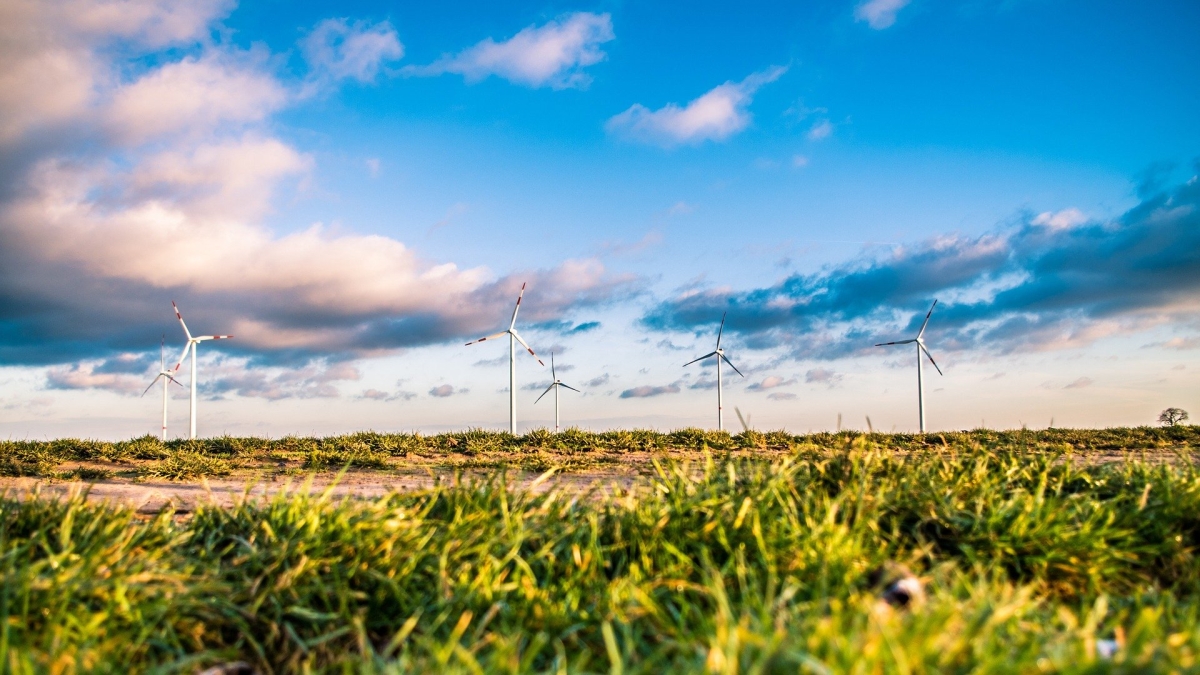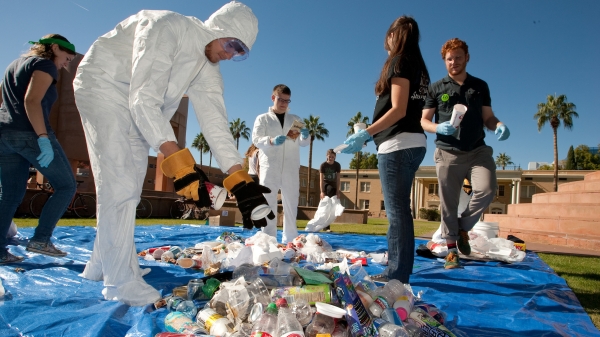After 50 years of Earth Day, ASU environmental experts see shift to grassroots activism
Professors see reason for optimism in the fight to save the planet

In the 50 years since the first Earth Day on April 22, 1970, the United States has moved from a focus on pollution to a broader awareness of how the ecosystem needs to be nurtured. And politics has shaped the way the country responds.
Two Arizona State University professors have been involved in environmentalism for decades: Joni Adamson, President's Professor of Environmental Humanities in the Department of English and director of the Environmental Humanities Initiative at the Julie Ann Wrigley Global Institute of Sustainability, and Paul Hirt, a professor of history specializing in the American West, environmental history and policy and sustainability studies.
They shared their thoughts on how the country’s attitudes toward saving the planet have changed over the past five decades.
The beginnings
Adamson: Earth Day was catalyzed by the Santa Barbara oil spill and the Cuyahoga River, which caught on fire. Those two events really put nationwide attention on environmental problems. In Santa Barbara, over 10,000 animals died. It’s like now in Australia, where a billion and a half animals are said to have perished in the wildfires. A lot of times, when animals die, that gets people's attention.

Joni Adamson. Photo by Deanna Dent/ASU Now
Hirt: There was the great cultural shift in the late 1960s and early ‘70s. It was, "We don’t have to accept a filthy, unhealthy environment to have jobs and prosperity." People were saying that they weren’t willing to accept that tradeoff any more.
And there was a bipartisan consensus that we needed federal and state action at the policy level to solve these intractable environmental problems.
A shift in the 1980s
Hirt: In the 1980s under Ronald Reagan, we had a new philosophy begin to take over the Republican Party that said that government was the problem, not the solution. The Democratic Party remained committed to legislation and regulation as a tool for problem solving, but the Republican Party rapidly shifted to thinking that the best way to a create prosperous economy was to unfetter big business.
Adamson: I started my master’s degree in the late '80s and continued my PhD at the University of Arizona, where I became involved in indigenous perspectives of the environment, which were different from mainstream environmentalists. Native peoples were concerned about toxins and pollutants and uranium contamination and coal tailings. Some environmentalists were more concerned with conservation and preservation of pristine forests.
Here in Arizona, among the indigenous people, there was a concern about environmental justice, balancing goods with risks. The indigenous people were saying that their resources were being taken and they were not getting a proportionate benefit, but the toxins are left. The benefit of electricity was going to Phoenix and Tucson and they were left with the coal tailings.
Environmentalism in Arizona
Hirt: From a historical perspective, I would say that Arizona has followed the trends of the rest of the United States.
In the 1970s, we were focused on natural resource conservation, sustainable land management and we were pretty strongly committed to adopting policies to push society in that direction. The 1980 Groundwater Management Act was a really comprehensive, important state law to get to sustainable water management. It was a sign of the times.
After 1980, it’s significant that no new water conservation laws have been passed except laws to weaken that one. That was the end of the period in which we believed in policy action, new laws and regulation to protect the environment.
And since then we went through a long period of trying to weaken government agencies and deregulate and make market transactions the tool we rely on to solve problems. I think we’ve all learned that just like policy tools are limited and sometimes have unintended consequences, market-based tools are limited and have unintended consequences.
Then climate change became a big focus in the ‘90s. And then suddenly it became politicized and, just like the rest of the nation, Arizona faced the conundrum of having one political party denying it was happening and not wanting to do anything about it and the other political party insisting it was happening and that we do something about it.
Adamson: I’ve been here since 1987. You can ask people who have been here at least 20 years if they’ve noticed a difference in the weather and most of us remember the summer monsoon coming on a regular basis from July to October. And most of us have noticed that we don’t get that anymore.
Even if you’re talking to a person who may not passionately believe in climate change, you can talk to them about things like the weather and they will agree that we’re not getting as much rain and the temperatures seem even hotter.
There’s an increase of awareness in Arizona around differences in the weather that are impacting us and will have an impact on the future.
Corporations step up
Adamson: When Walmart shifts to less packaging, which it has done, it reduces transportation costs and it impacts everybody in its supply chain around the world. Somebody making a toy in China has to reduce packaging. Walmart also has made steps in the right direction in food waste, which accounts for 8% of our greenhouse gases. We need more of that corporate accountability.

Paul Hirt
Hirt: My philosophy has always been that we need to use every tool in the toolbox and we need all hands on deck.
You’re not going to solve all the problems with policies and you’re not going to solve all the problems with moral suasion and education. You’re not going to solve all the problems by appealing to consumers and the individual to behave properly. And you’re not going to solve all the problems by encouraging corporations to be responsible and sustainable.
They’re all pieces of a larger puzzle that have to work together and you need everybody — everybody — with the capacity to make better choices to get committed to doing that.
Grassroots activism
Hirt: One of the consequences of legislative gridlock is that you can’t turn to the political arena to solve problems. You can’t get bills through or the bills that get through are so compromised they don’t do anything.
And that’s when we start turning to the local level and to the corporate level, and (nonprofits), saying, "If we can’t turn to the state legislatures or our U.S. Congress to solve these problems, we won’t wait on them, we’ll just do what we can." It might be a bunch of students or a nonprofit organization that decides to engage in education or a corporation like Microsoft or Intel or Apple saying, "We’re going to adopt 100% renewable energy over the next 10 years."
Adamson: When you look across the nation, some of the most innovative response to climate change is happening in the cities. For example, in Miami, where they cannot deny climate change because the ocean is rising and they’re seeing sunny-day flooding, we’re seeing a lot of innovative policy and infrastructure changes.
Hirt: The last really significant reform period in American history was at the turn of the 20th century, called the Progressive Era. We had a Republican president, Teddy Roosevelt, in charge and that’s when the philosophy of conservation was invented and promoted globally.
But there was still a general sense in America that the federal government should be weaker than the state government and that local action was better than national action. So it was difficult for Teddy Roosevelt to really generate a national movement. He did a lot but there was a lot of pushback.
When historians went back and looked at the Progressive Era, they said, "Where did that reform impulse come from?" And if you look closely at all the evidence, it turns out that all of that reform started at the city level. Progressive Era reform bubbled up from the grassroots, and we had the first progressive policy adopted at the city level and then it graduated to the state level and then it became a national phenomenon. But in American history we tend to look at the most famous people and the top of the food chain, the president and legislators.
Adamson: And we’re seeing this again. I think the current administration has catalyzed a lot of local action because when the U.S. pulled out of the Paris Climate Agreement, there was a lot of disappointment. And people realized that we need to act now and this will have to happen from the ground up
The promise of technology
Hirt: We’re in a period of rapid economic and technological change so we’re seeing reform being generated by technological innovation, such as Tesla and the improvement in battery technology leading to a mass-market electric car that’s affordable and fun to drive.
The same thing with solar. We did enough mass production and technological innovation in solar and wind energy to drive the costs down to the point where clean energy is now cheaper than dirty energy.
But Americans didn’t ask thorough questions very often before the 1960s to say, "Is endless growth something we really want?" It’s the same thing with innovation. Not every new technology is one we want to embrace and produce at scale.
Adamson: This is this great thing about 50 years of Earth Day is that we’ve seen the movement from sustainable development, which was oriented toward business, to this huge idea that our planet is a system and we have to be concerned with the way humans and animals and plants interconnect. It’s an ecosystem.
On being optimistic
Hirt: I struggle with optimism and pessimism but I am strategically optimistic.
If you can’t give your students examples of problems being solved, you can’t inspire and empower them to become problem solvers. For every time I teach about how we screwed something up I concertedly come up with an example of how we fixed something.
Whenever I hear somebody say, "The end is nigh," I remember all the times in history that has been said with great conviction and they were wrong. The future will be what we make it.
Adamson: When you walk into a classroom how can you not be optimistic? How will you get the next generation passionate and involved? I teach them about food systems and food waste, where they can really make a difference. We can turn this around in this decade. You have to have faith that this is the generation to make a difference.
Top image by Pixabay
More Environment and sustainability

Celebrating Earth Day around the world
Originating in the United States in 1970, Earth Day is now celebrated worldwide. But even before it became an official day, many countries were already mindful of their carbon footprint in their…

A run on fossil fuels: ASU professor says climate legislation could have unintended consequences
As concerns about climate change grow, policymakers are increasingly voicing support for stricter fossil fuel legislation. Their discussions and proposals raise questions about the future of the oil…

Confusion complicates US recycling efforts
In most major cities and buildings, recycling bins can often be found alongside trash bins in an effort to encourage recycling. But is it working? According to the U.S. Environmental Protection…